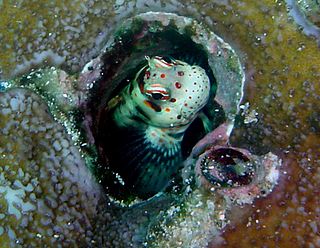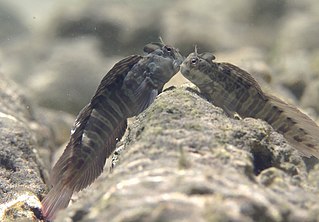
Combtooth blennies are blenniiformids; percomorph marine fish of the family Blenniidae, part of the order Blenniiformes. They are the largest family of blennies with around 401 known species in 58 generas. Combtooth blennies are found in tropical and subtropical waters in the Atlantic, Pacific and Indian Oceans; some species are also found in brackish and even freshwater environments.

Salarias fasciatus is a popular marine aquarium fish species in Australasia. Despite being also known as the lawnmower blenny due to its propensity to consume algae growth from rocks and glass, it is principally a detritivore, with plant material making up only 15% of its diet. This species reaches a length of 14 centimetres (5.5 in) TL. The lawnmower blenny is generally regarded as compatible with most other marine fish species and as a group with other lawnmower blennies.

The Australian blenny is a small marine blennioid fish of the genus Ecsenius. They are small and reddish brown with a white ventral side. Australian blennies inhabit the shallow marine waters of the tropics. They are often found along the Great Barrier Reef and Coral Sea of Australia.

The Pacific leaping blenny, also known as the leaping rockskipper, is a species of combtooth blenny in the genus Alticus. The blennies are oviparous, and form distinct pairs when mating. Males can reach a maximum total length of 8 centimetres. These fish feed primarily on benthic algae, which they consume by scraping off rocky surfaces.

Blenniella is a genus of combtooth blennies found in the Pacific and Indian Oceans.

Blenniella bilitonensis, also known as Biliton blenniella or the lined rockskipper, is a species of combtooth blenny found in the western Pacific ocean.
Blenniella caudolineata, the blue-spotted blenny, is a species of combtooth blenny found in coral reefs in the Pacific ocean.

Blenniella cyanostigma, the striped rockskipper, is a species of combtooth blenny found in coral reefs in the Indian Ocean.

Blenniella paula, the blue-dashed rockskipper, is a species of combtooth blenny found in coral reefs in the western Pacific ocean.

Blenniella periophthalmus is a species of combtooth blenny found in coral reefs in the Pacific and Indian oceans. It is commonly known as the blue-dashed rockskipper, bullethead rockskipper, false rockskipper, or the peppered blenny.

Istiblennius is a genus of combtooth blennies found in the Pacific and Indian Oceans. The generic name is a compound noun composed of istio the Greek for "sail", referring to the high dorsal fin of the type species, Istiblennius muelleri, and blennius which is derived from a word for "mucus" and refers to the scaleless bodies that characterise the Blenniidae.

Istiblennius bellus, the imspringer, is a species of combtooth blenny found in coral reefs in the Pacific and western Indian ocean. It is also known as the beautiful rockskipper or the dusky blenny. Males of this species can reach a maximum of 16 cm (6.3 in) SL, while females reach a maximum of 13.1 cm (5.2 in) SL.

Istiblennius dussumieri, the streaky rockskipper, is a species of combtooth blenny found in coral reefs in the western Pacific and Indian Oceans. It is also commonly known as the Dussumier's rockskipper, streaky dussumier, or the Dussumier's blenny.

Istiblennius edentulus, the rippled rockskipper, is a species of combtooth blenny found in coral reefs in the Pacific and Indian Oceans. It is also commonly known as the rippled blenny, smooth-lipped blenny, toothless blenny, or coral blenny. Males of this species can reach a maximum of 16 cm (6.3 in) TL, while females can reach a maximum of 13.2 cm (5.2 in) SL.

Istiblennius lineatus, the lined rockskipper, is a species of combtooth blenny found in coral reefs in the Pacific and Indian oceans. It is also commonly known as the lined blenny, black-lined blenny, or thin-lined rockskipper. It can reach a maximum of 15 cm (5.9 in) TL. This species can be found in the aquarium trade.

Istiblennius meleagris, the peacock rockskipper, is a species of combtooth blenny found in coral reefs in the western Pacific ocean. It is also known as the white-speckled blenny. Males can reach a maximum of 15 cm (5.9 in) TL, while females can reach a maximum of 10.6 cm (4.2 in) SL.
Istiblennius muelleri, Mueller's rockskipper, is a species of combtooth blenny found in the western Pacific ocean. Males of this species can reach a maximum of 7 cm (2.8 in) SL, while females can reach a maximum of 5.5 cm (2.2 in) SL. The specific zoology honours the German-Australian physician, geographer, and botanist Ferdinand von Mueller (1825-1896).

Istiblennius unicolor, the pallid rockskipper, is a species of combtooth blenny found on coral reefs in the western Indian Ocean. Males of this species can reach a maximum standard length of 10.2 cm (4.0 in), while females can reach a maximum length of 9.2 cm (3.6 in).

Ophioblennius steindachneri, the large-banded blenny or the Panamic fanged blenny, is a species of combtooth blenny found in coral reefs in the eastern Pacific ocean. This species reaches a length of 18 centimetres (7.1 in) SL.

Plagiotremus rhinorhynchos, commonly called the bluestriped fangblenny, is a species of combtooth blenny found in coral reefs in the Pacific and Indian ocean. This species reaches a length of 12 centimetres (4.7 in) SL. It is also known as the bluestriped blenny, bluestriped sabretooth blenny, blunt-nose blenny, cleaner mimic, tube-worm blenny or the two-stripe blenny. They hide in deserted worm tubes or other small holes.



















